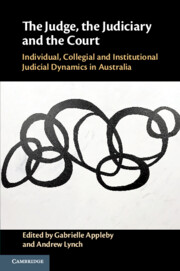 The Judge, the Judiciary and the Court
The Judge, the Judiciary and the Court from Part I - The Judge, the Judiciary and the Court
Published online by Cambridge University Press: 04 May 2021
Australia has a uniquely developed constitutional discourse as to the nature of judicial power. However, this focus on constitutionality has at times tended to obscure a deeper reflection on the underlying concept of the scope of the judicial role. This approach elevates the permissible over the ideal.
It is against this context that this chapter presents a systematic and coherent articulation of the judicial function as a conceptual, rather than constitutional, inquiry. It argues that this function involves a unique institutional blend of dispute resolution and social governance. In the current Australian judicial environment, with its particular focus on efficiency and ‘collegiality’, this explicit recognition of the dualist nature of the judicial role is controversial but critical.
The chapter develops a taxonomy for the systematic characterisation of dispute resolution methods generally, which clearly delineates the judicial form of dispute resolution. It outlines how dispute resolution mechanisms can operate as tools of social governance and explores specifically how the judiciary operates s such an institution. The expansive articulation of function set out in this chapter invites a critical reflection of the limits, constraints, and purposes of the judicial role. The chapter concludes by exploring how this approach may better inform a number of issues facing the contemporary Australian judiciary
To save this book to your Kindle, first ensure no-reply@cambridge.org is added to your Approved Personal Document E-mail List under your Personal Document Settings on the Manage Your Content and Devices page of your Amazon account. Then enter the ‘name’ part of your Kindle email address below. Find out more about saving to your Kindle.
Note you can select to save to either the @free.kindle.com or @kindle.com variations. ‘@free.kindle.com’ emails are free but can only be saved to your device when it is connected to wi-fi. ‘@kindle.com’ emails can be delivered even when you are not connected to wi-fi, but note that service fees apply.
Find out more about the Kindle Personal Document Service.
To save content items to your account, please confirm that you agree to abide by our usage policies. If this is the first time you use this feature, you will be asked to authorise Cambridge Core to connect with your account. Find out more about saving content to Dropbox.
To save content items to your account, please confirm that you agree to abide by our usage policies. If this is the first time you use this feature, you will be asked to authorise Cambridge Core to connect with your account. Find out more about saving content to Google Drive.